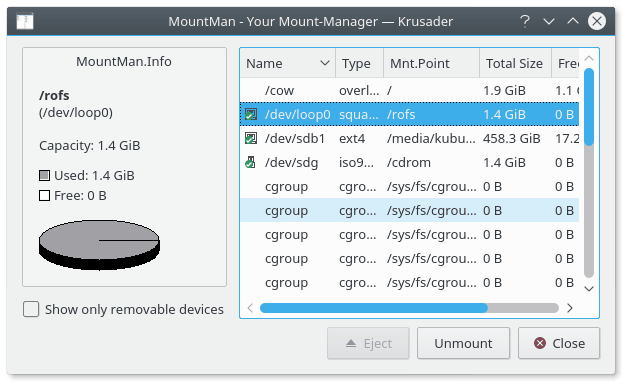MountMan is a tool which helps you manage your mounted file systems. Once
invoked, it displays a list of every mounted file system. For each file system,
MountMan displays its name (which is the actual device name - i.e. /dev/sda1 for a first partition on first
HDD), its type (ext4, ext3, ntfs, vfat, ReiserFS...)
and its mount point on your system (the folder on which the file system
is mounted).
If you want filter out non-removable devices from the list, just check the item Show only removable devices at the left of the device list.
MountMan also displays usage information using total size, free size, and percentage of available space free. If those numbers say N/A, that usually means that the file system is not mounted. Left clicking on a file system displays a pie chart on the left of the window, graphically displaying the usage information for the file system. Clicking on a non-mounted file system will display not mounted instead of the graph.
Double-clicking on a file system will close MountMan and open that file system inside Krusader's active panel.
Right-clicking on a file system will open a small menu which displays what actions can be performed on that file system. At the moment, you can only mount, unmount and eject (if clicking on a removable file system, e.g., a CD-ROM).
Note
We plan to expand MountMan in the next evolution of Krusader. It will be able
to format partitions, edit /etc/fstab,
create new file systems and more.... By the way, we have started working on it,
see “Quickmode for MountMan”.
Quickmode for MountMan
To activate Quickmode for MountMan, click lateral button with arrow on the MountMan button on the Main Toolbar.
General idea: display a list of all possible mount points. Each time the menu is displayed, it determines if a mount point is mounted or not and associates the correct action (mount or umount). This offers a quick interface to MountMan. It is working, and currently uses KMountMan::mount and unmount. It uses the new KDE Frameworks™ 5 services for fstab-reading and this will enable us to remove a lot of code from the “old” MountMan.
